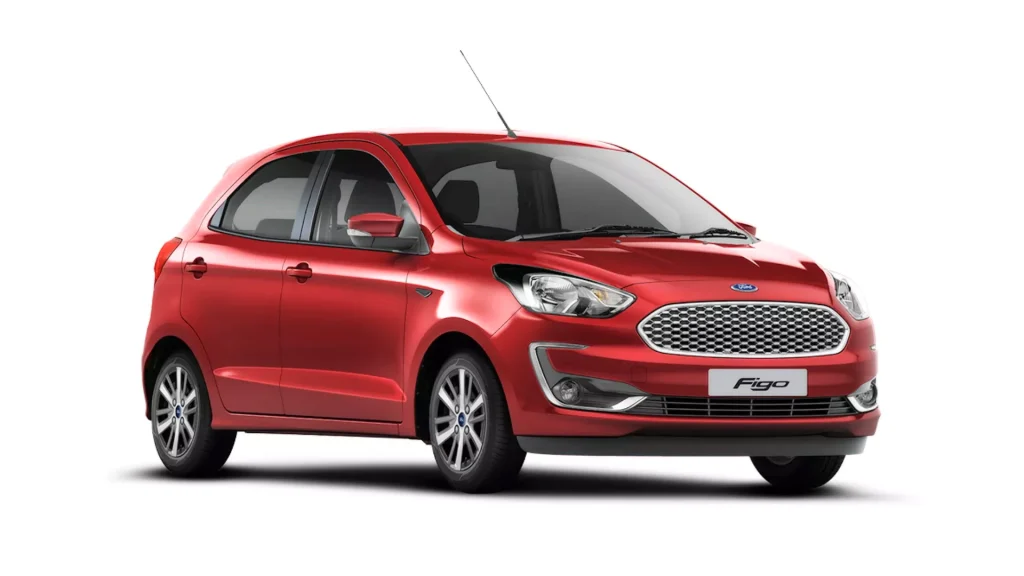Ford Figo Cars
Introduction for Ford Figo Cars
There is a lot riding on the small shoulders of this second generation Ford Figo hatchback. Although the EcoSport has been doing pretty well, it’s a small hatch that gets you big numbers in a developing country like India. The Ford Aspire sub-compact sedan has been well received by Indian car buyers and without a doubt has aroused a positive response in the market. In an effort to follow up on this good reaction, the American car maker has quickly launched the Figo, which is essentially the hatchback iteration of the Aspire. Ford Figo Cars.
Like with the sedan, Ford has spared no effort in making the Figo as good as it can be. It’s spacious, well equipped, has strong engines and is quite nice to look at. Ford seems to have nailed it with the pricing especially for the base and mid variants and this definitely puts the Figo in good stead. However, price and equipment is not the only determining factor of a car’s success and the Figo has to deliver as an all-rounder.

Design and Style for Ford Figo Cars
The Figo hatchback looks identical to the Aspire sedan right up to the C-pillar. As a result, like with the sedan, the huge Aston Martin-like grille dominates the face of the Figo. The four slim chrome bars add a bit of flair to this aggressive front. Lower down in the front bumper, there are slimmer air dams that extend a bit further, and the sporty look is accentuated by cut-outs in which the fog lamps are accommodated. In profile, thanks to the hatch shape, the Figo looks more balanced than its sedan brother and the character line running across the side gives it a good stance. At the rear, Ford has kept things simple and uncluttered. But the neat wrap-around tail-lamps and the creases running across the boot lid helps it look interesting. The small 14-inch rims, though, looks a bit too small on such a large body.
Underneath, the Figo
Underneath, the Figo, like every other hatchback uses a monocoque chassis. It is based on the popular B2E platforms which also underpinned the recently discontinued Fiesta (2011) sedan. But despite having a similar 2491mm wheelbase as the Fiesta, the Figo is a massive 120kg lighter. This is thanks to Ford using lighter high-strength steel for the doors. As the roof is ribbed, Ford has managed to use thinner metal which has saved further weight. Although, Ford claims the car hasn’t lost any of the body rigidity, it doesn’t feel as solid as the Fiesta. This is particularly apparent with the door shut, which lacks the Fiesta’s or the EcoSport’s solid thunk.
The new Figo is suspended by a conventional independent MacPherson front and non-independent rear suspension layout. In terms of stopping power, Ford has employed discs up front and drums at the rear. Discs all round would have been welcome, considering the Figo is one of the fastest hatchbacks in the country.
Interiors for Ford Figo Cars
When you enter the Figo’s lodge, you are welcomed by the recognizable Passage dashboard. The jutting mid control area with its horde buttons is a piece overwhelming to utilize, while the data screen is little and looks a piece obsolete. In the lower Titanium variation, you miss the screen yet rather you get the Portage Dock on the mid control area. It’s a rubberised telephone holder which functions admirably and an incredible element for those depend on their telephones for GPS.
The plastics, however, don’t have the extravagance you currently expect in a major portal yet generally the materials feel hardwearing and the switchgear has a strong, worker like feel. That separated, the dashboard looks jazzy and we especially preferred the little breadth etched guiding wheel. At the front, there are a lot of extra rooms yet peculiarly, there is just a single cup holder and seatback pocket at the back.
The front seats are well contoured and driving position is good. Even at the back, you’ll find no issue with the legroom on offer and headroom is decent as well. What you might not like is the narrow cabin and the lack of adjustable headrests. But the bench itself is supportive with a nice seatback angle. The boot, at 257 litres, is decent by segment standards and although you don’t get split seats, you can fold the rear seat flat for added luggage space.
Safety and Equipment for Ford Figo Cars
As far as wellbeing, the Figo is somewhat of a mishmash. While even the base variation comes furnished with the driver’s airbag as standard, just the top variations get ABS. The mid variations convey two airbags while the best in class Titanium + variation gets upwards of six airbags as standard. The Titanium + variation additionally get other exceptional highlights like Passage’s My Key and Microsoft’s SYNC. The Figo programmed then again comes just in the mid Titanium variation and passes up these remarkable highlights, yet it comes outfitted with foothold control. As far as standard gear, the Figo passages well. It is accessible with the basics like environment control, power windows, Compact disc player with aux-in and USB availability, Bluetooth communication, directing mounted controls and others. What we profoundly missed on the vehicle however is a touchscreen interface, leaving sensors and controlling reach change.
Engine, Performance and Braking for Ford Figo Cars
The Figo, similar the Desire, gets three motor choices. There are two petrols – 1.2 liter with manual transmission and a 1.5-liter coupled to a six-speed double grasp gearbox. The diesel heart uproots 1.5litres and is really great for almost hundred ponies. We should begin with the petroleum programmed first. The Figo utilizes a similar 1499cc petroleum and six-speed double grasp gearbox blend as the one found on the Aim and the EcoSport. It delivers an exceptionally sound 111bhp which is extraordinary thinking about how light the vehicle is.
Around, opened in ‘D’ mode, the programmed gearbox upshifts early, keeping a somewhat low motor speed in a bid to further develop efficiency. A touch on the choke gets it going very well, and when driven with care it is a seriously ideal city vehicle. Be that as it may, at part choke the gearbox in some cases gets confounded and this makes the power conveyance very jerky when you need to gain speedier headway. You in the end figure out how to cruise all over this lack and when you go level on the gas pedal, the Figo feels enthusiastic and appropriately fast. The motor however gets very thrummy when the vehicle is driven thusly and this is where fans will be frustrated. Indeed, even the gearbox however nice all alone is very disheartening contrasted with other double grips.
Tech transmission.
It is very delayed to answer and you can really feel the stuff changes which is a piece surprising for a greetings tech transmission. At the point when you shift to wear mode, the gearbox turns into a piece faster as it clutches gears for longer. You can likewise change gears physically, yet to do that the medium is a piece bizarre – there is a little button that in essence stowed away from view on the stuff switch. Still the Figo programmed is a seriously fast vehicle with 100kmph coming up in a noteworthy 11.3 seconds.
Shockingly the diesel captures
Shockingly the diesel captures everyone’s attention, taking everything into account. When you turn over the motor you understand that this 1498cc motor very refined. This normal rail diesel produces an exceptionally great 99bhp and 216Nm of max pulling power. Power conveyance is really consistent and you can scarcely feel the super kicking in. There’s a delicate flood at around 1700rpm, trailed by major areas of strength for a till the 3800rpm past which it’s ideal to upshift. What’s likewise great is that the motor has a genuinely impressive push so you don’t need to work the smooth-moving gearbox to continually gain speedy headway.
The strong motor joined with its generally low weight intends that undoubtedly, the Figo is the quickest financial plan diesel hatch in the country. The 0-100kmph run requires a sparse 10.3 seconds! That makes it quicker than the significantly more costly VW Polo GT TDI as well. Indeed, even its in-gear timing are exceptionally amazing with 20-80kmph in third stuff requiring simply 10.53 seconds. Regardless of whether the Figo get the overall circle arrangement, the brakes loan a very sizable amount of halting power for this strong seal. What assists the straight feel at the pedal, which assists you with knowing precisely how much strain required.
Ride and handling
Contrasted with the old Figo the enhanced one has lost a portion of its energy. In view of a more extensive crowd, Portage has given ride and solace priority over contribution and dealing with. Accordingly, save for some solidness at low speed, the Figo remains courageous and the refined suspension just approaches its work, keeping you segregated from the greatest of potholes. Straight-line strength is great and rapid habits are very great as well. Despite the fact that there is some drifting movement over undulating surface at speed, it never gets awkward and the driver generally feels in charge by and large.
Giving Passage has gone delicate with the new age Figo it actually feels very nimble by class principles. The vehicle shows great balance when pushed hard and there is good hold as well. However, the obstacle here is the directing which has a touch of slack, is slow and feels inert in any event, when you are pushing hard.
Price and fuel economy
While the lower variations of the Figo are very much valued, the best in class Titanium + variation is very costly. The petroleum Figo’s costs start from a low Rs 4.30 lakh for the base and go up to Rs 6.41 lakh for the Titanium + variation. The diesel costs start at Rs 5.30 lakh for the base and go up to a huge Rs 7.41 lakh for the top variation. The programmed transmission is just accessible in the 1.5 petroleum and the lower Titanium variation and it retails at a serious Rs 4.92 lakh.
As far as mileage, the petroleum programmed expectedly was the thirstier of the two. The 1.5 AT variation returned a decent 11.7kpl in the city and 15.5kpl on the roadway. The diesel variation, then again, ended up being incredibly productive with figures of 14.1kmpl and 19.6kmpl for the city and thruway cycles separately. These great figures likewise accomplished thanks to the vehicles’ low kerb weight.
Verdict
So has Portage conveyed an item to inconvenience the could of the Maruti Quick and tasteful Hyundai Great i10? After our thorough street test the Figo vows to be in excess of a counterpart for its rivals. It is roomy, agreeable, looks great, has the most grounded diesel motor and it conveys class-matching mileage as well. What makes the Figo family much more appealing the expansion of a strong programmed petroleum choice which ought to draw in a significant number metropolitan purchasers. Indeed, a more upmarket scramble and better quality would have gladly received. However, as with the old Figo, Portage has figured out how to value the new Figo all around well, which makes it a much better arrangement. Has Passage set the benchmark in the portion? We are getting Figo’s three direct rivals together to offer you a response. Remain tuned.


